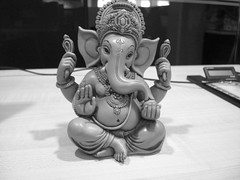Ganesha

One characteristic of polytheistic religions is that there is often less of a tendency to accept authority.
For instance, one might think that the Hindu God Ganesh might have an agreed-upon provenance. For us, sadly, it seems not to be so.
Wikipedia has this to say about Ganesh:
Ganesha has been represented with the head of an elephant since the early stages of his appearance in Indian art.[42] Puranic myths provide many explanations for how he got his elephant head.[43] One of his popular forms, Heramba-Ganapati, has five elephant heads, and other less-common variations in the number of heads are known.[44] While some texts say that Ganesha was born with an elephant head, in most stories he acquires the head later.[45] The most recurrent motif in these stories is that Ganesha was born with a human head and body and that Shiva beheaded him when Ganesha came between Shiva and Parvati. Shiva then replaced Ganesha's original head with that of an elephant.[46] Details of the battle and where the replacement head came from vary according to different sources.[47] In another story, when Ganesha was born, his mother, Parvati, showed off her new baby to the other gods. Unfortunately, the god Shani (Saturn), who is said to have the evil eye, looked at him, causing the baby's head to be burned to ashes. The god Vishnu came to the rescue and replaced the missing head with that of an elephant.[48] Another story says that Ganesha was created directly by Shiva's laughter. Because Shiva considered Ganesha too alluring, he gave him the head of an elephant and a protruding belly.[49]
and
Though Ganesha is popularly held to be the son of Shiva and Parvati, the Puranic myths disagree about his birth.[101] He may have been created by Shiva,[102] or by Parvati,[103] or by Shiva and Parvati,[104] or appeared mysteriously and was discovered by Shiva and Parvati.[105]
Also according to Wikipedia:
Ganesha is identified with the Hindu mantra Aum (ॐ, also called Om). The term oṃkārasvarūpa (Aum is his form), when identified with Ganesha, refers to the notion that he personifies the primal sound.[94]
As the god of transitions, he is placed at the doorway of many Hindu temples to keep out the unworthy...
Ganesha appeared in his classic form as a clearly-recognizable deity with well-defined iconographic attributes in the early 4th to 5th centuries.
===
... and speaking of Pantheism - any guesses as to how many Hindu Gods there are?
The Vedas, the earliest comprehensive literature of the Indo-European people, contain mantras for pleasing the devas to obtain blessings. The Rig Veda, the earliest of the four, enumerates 33 devas, which in later Hinduism became exaggerated to 330 million, likely because the same Sanskrit word means "ten million" and "class, group", i.e. "33 types of divine manifestations".
Now THAT's an abundance of riches!


1 Comments:
Ganesha is my Lord.When I wake up in morning then first I Prays to Ganesha.Ganesha is a son of Shiva and Parvati ji.Ganesha is identified with OM.Ganesha's best mantra is Om Gan Ganpate Namah and Shivaji's best mantra is OM NAMAH SHIVAY
Post a Comment
<< Home